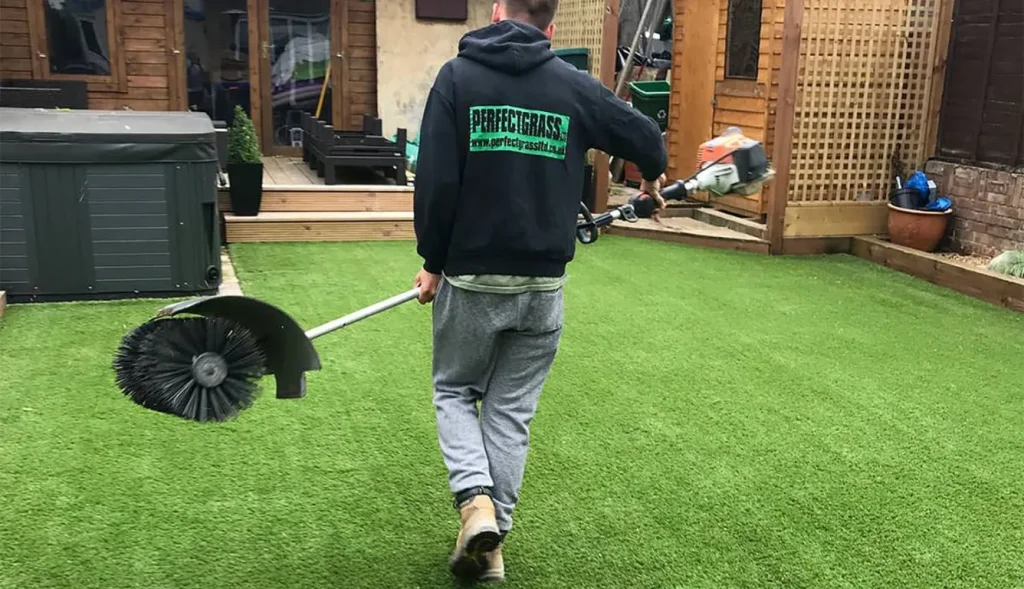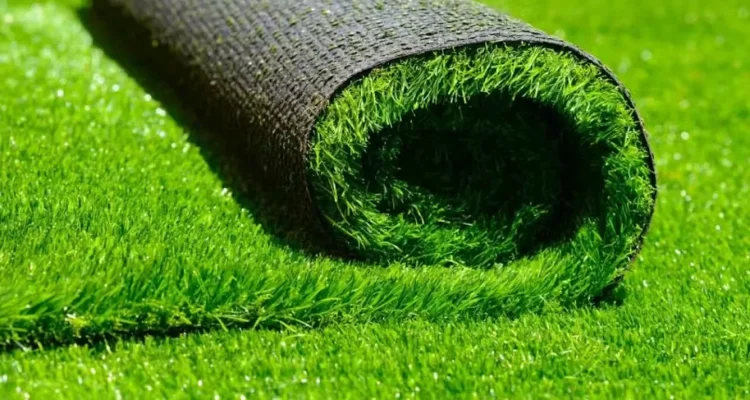Introduction
Artificial grass has revolutionized lawn care, offering a stunning, green space with minimal upkeep. But to keep it looking pristine, you’ll need to perform regular maintenance. From cleaning to repairs, this guide will help you maintain your artificial grass so you can enjoy a beautiful lawn without the hassle of traditional grass care.

Routine Cleaning
Removing Debris
Keeping your artificial grass free from debris is crucial for its appearance and longevity.
- Using a Leaf Blower: A leaf blower is an excellent tool for removing leaves, twigs, and other debris quickly. Simply blow the debris off the surface and away from the edges.
- Manual Removal: For smaller debris or in areas where a leaf blower can’t reach, use a broom or rake with soft bristles to gently sweep the surface.
Washing the Surface
Periodic washing helps remove dust and dirt.
- Using a Garden Hose: Rinse your artificial grass with a garden hose to wash away dirt and small particles. Make sure to use a gentle spray to avoid damaging the fibers.
- Specialized Cleaning Solutions: For a deeper clean, you can use solutions specifically designed for artificial grass. These cleaners are formulated to break down grime and maintain the color and texture of your grass.
Deep Cleaning
Shampooing the Grass
A more thorough cleaning is recommended every few months.
- Selecting the Right Cleaner: Choose a cleaner that is safe for synthetic materials and does not contain harsh chemicals.
- Application Techniques: Apply the cleaner evenly across the grass using a sponge or brush. Gently scrub the surface to lift dirt and stains.
Rinsing and Drying
After shampooing, proper rinsing and drying are essential.
- Proper Rinsing Methods: Use a hose to rinse off all the cleaning solution thoroughly. Ensure that no residue is left behind.
- Ensuring Complete Dryness: Allow the grass to air dry completely before using it. Avoid walking on the wet surface to prevent flattening the fibers.
Handling Stains and Spills
Common Stains
Stains can affect the look of your artificial grass.
- Pet Urine: Blot the area with paper towels, then clean with a mixture of water and vinegar. Rinse thoroughly.
- Food and Drink Spills: For spills, quickly clean the area with a mixture of water and mild detergent. Rinse well.
Stain Removal Techniques
- Spot Cleaning: Address stains as soon as they occur to prevent them from setting in. Use a clean cloth and gentle cleaning solution.
- Using Vinegar and Baking Soda: For tougher stains, sprinkle baking soda on the area, then spray with a vinegar solution. Let it sit for a few minutes before scrubbing and rinsing.
Dealing with Weeds
Preventive Measures
Weeds can grow through artificial grass if not properly managed.
- Weed Barrier Fabric: Install a weed barrier fabric beneath the grass during installation to prevent weed growth.
- Pre-Emergent Herbicides: Apply pre-emergent herbicides to stop weed seeds from germinating.
Removing Existing Weeds
- Manual Removal: Pull weeds by hand or use a weed removal tool. Ensure you remove the entire root to prevent regrowth.
- Herbicide Application: Use a selective herbicide designed for synthetic surfaces if weeds are persistent.
Maintaining the Infilling
Types of Infilling
Infilling helps support the grass fibers and provide stability.
- Rubber Granules: Rubber infill is popular for its cushioning and durability.
- Sand: Sand infill is another option that helps keep the grass blades upright.
Replenishing Infilling
- How to Add More: Spread infill evenly across the surface using a spreader or rake.
- Even Distribution Techniques: Ensure the infill is evenly distributed to maintain a consistent appearance and feel.
Checking for Damage
Common Issues
Inspect your artificial grass regularly for any signs of wear.
- Rips and Tears: Look for any visible damage and address it promptly.
- Uneven Surface: Check for areas that may have shifted or settled unevenly.
Repairing Damage
- Patch Kits: Use patch kits to fix small rips and tears. Follow the manufacturer’s instructions for a seamless repair.
- Professional Repairs: For more significant damage, consider hiring a professional to ensure proper repair and avoid further issues.
Preventing Mold and Mildew
Ventilation and Drainage
Proper drainage is key to preventing mold and mildew.
- Ensuring Proper Drainage: Make sure your artificial grass has adequate drainage to avoid water pooling.
- Keeping the Grass Dry: Remove any standing water promptly and ensure good airflow around the grass.
Mold and Mildew Cleaners
- Safe and Effective Products: Use cleaners specifically designed to tackle mold and mildew on synthetic surfaces. Follow the product instructions for best results.
Seasonal Maintenance Tips
Summer Care
Artificial grass can be affected by high temperatures.
- Dealing with Heat and UV Exposure: Use a UV protectant spray if your grass is exposed to intense sunlight. Regularly rinse the surface to keep it cool.
Winter Care
Winter weather can impact your artificial grass.
- Handling Snow and Ice: Gently remove snow using a plastic shovel. Avoid using metal shovels or salt, as they can damage the grass.
FAQs
How often should I clean my artificial grass?
Regular cleaning every 1-2 weeks is recommended, with deep cleaning every few months.
Can I use a pressure washer on artificial grass?
It’s best to avoid pressure washers as they can damage the fibers. Use a garden hose for cleaning.
What should I do if my artificial grass starts to smell?
Clean the area with a mixture of water and vinegar, and ensure proper drainage to prevent odors.
How do I keep my artificial grass from flattening?
Brush the grass regularly to lift the fibers and distribute the infill evenly.
Is artificial grass maintenance more cost-effective than natural grass?
While the initial cost may be higher, artificial grass generally requires less maintenance and water, making it more cost-effective in the long run.

Conclusion
Maintaining artificial grass involves regular cleaning, checking for damage, and taking preventive measures to ensure it stays in great shape. By following these tips, you can enjoy a vibrant, low-maintenance lawn all year long. Proper care not only enhances the appearance of your grass but also extends its lifespan, making it a worthwhile investment for your home.


Congratulation!